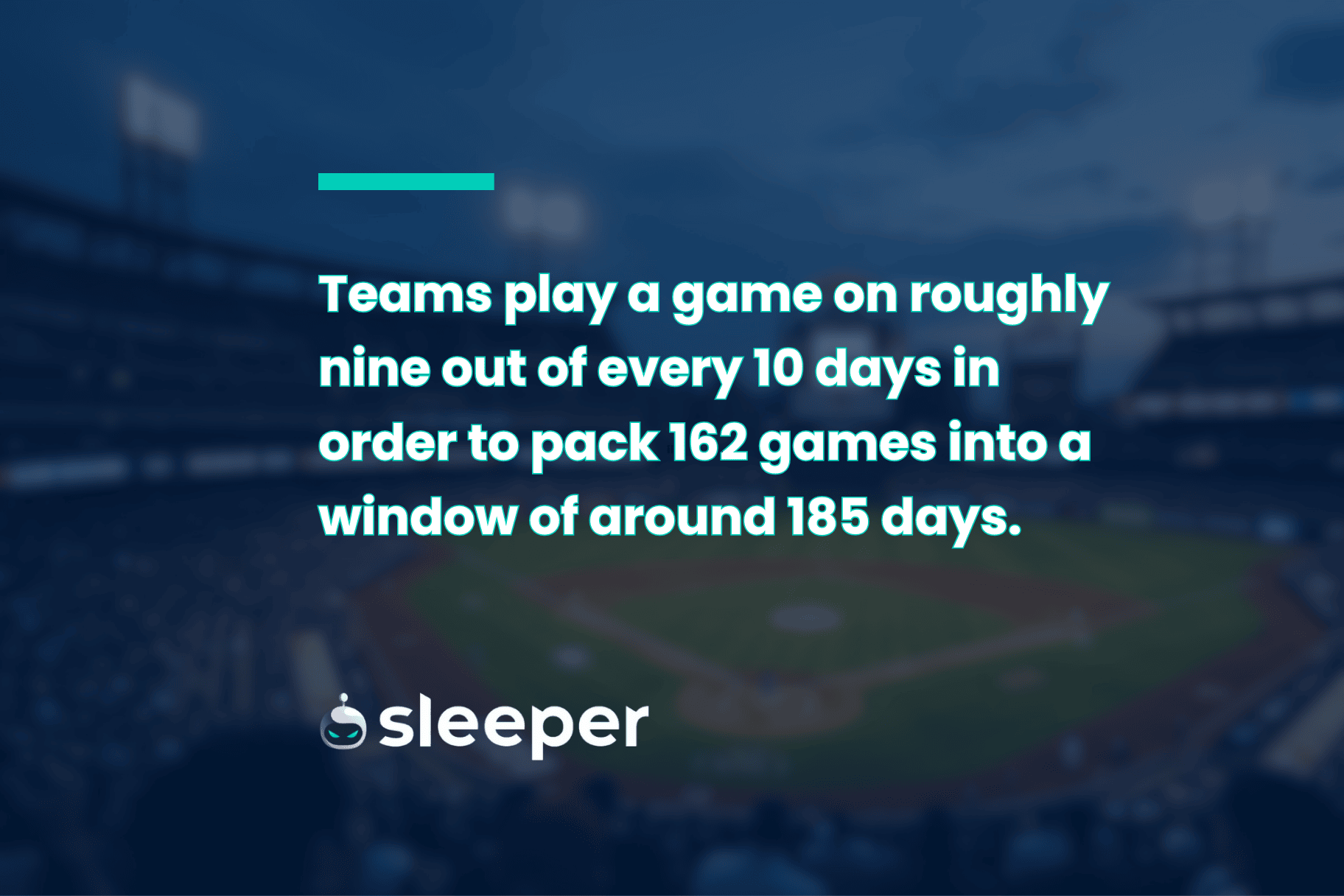There are more games in an MLB season than there are in any other professional sport, and the breakdown of a campaign all plays into your fantasy baseball strategy.

Major League Baseball’s regular season is played over the course of six months, usually with 15 games played per day.
It might feel like that equates to around a million games, particularly in the doldrums of August when each team has played more than 100 games and yet postseason baseball is still not on the horizon.
In reality, the MLB season is designed to have 2,430 games played, followed by a month-long postseason to crown the World Series champion.
It has been 2,430 games every year (except 2020) since the last round of MLB expansion in 1998, but neither that league-wide total nor the team-specific count of 162 games per season has always been the case.
We’ll go through some of the history of MLB’s season length before discussing all things schedules, series and even how it’s relevant to fantasy baseball strategy.
How Many Games Does Each Team Play in a Baseball Season?
Each MLB team plays 162 games during the regular season, which traditionally has been the length of a regular season dating back to the early 1960s. (1962 for the National League and 1961 for the American League.)
There were only 60 games played during the COVID-truncated 2020 campaign. The 1972, 1981, 1994 and 1995 seasons were also shortened due to labor strikes. Far more often than not, though, it has been 162 games per team per season for more than six decades.
Prior to the increase to 162 in the early 1960s, though, each team played 154-156 games on an annual basis dating back to the early 1900s. Go back to the pre-World Series days of early, early baseball, though, and the schedule wasn’t exactly standardized. (They didn’t wear gloves or helmets back then either, by the way.)
Inevitably, weather postponements throw a wrinkle into the meticulously crafted league-wide schedule. Rain outs—or the occasional snow out—sometimes force doubleheaders to be played on the following day, or games to be made up later in the season.
Every once in a while, a game will get outright canceled if it isn’t ‘reasonably convenient’ to reschedule it and it ends up not having any impact on postseason seeding. There were no such cancellations in 2022 or 2023, but there was a Houston-Cleveland rain out on the final day of the 2024 regular season that wasn’t made up, leaving each of those teams with just 161 games played that year.

How Is the MLB Season Structured?
It all starts in Spring Training, with pitchers and catchers typically reporting to their Arizona- or Florida-based camps around Valentine’s Day. Position players show up five days later, and the first Spring Training games get underway just a few days after that.
Spring Training runs until about three days before the regular season begins, either in the final few days of March or the first few days of April.
‘MLB World Tour’ games sometimes necessitate a sort of soft launch for Opening Day, like in 2019 when the Seattle Mariners and Oakland A’s played on March 20-21 in Tokyo, or in 2024 when the Los Angeles Dodgers and San Diego Padres met also on March 20-21 in Seoul. But it’s typically March 31 plus or minus three days when everyone’s regular season gets underway.
From there, let the six-month marathon begin.
Save for the four-day break for All-Star Game festivities at some point in early-to-mid July each year, teams play a game on roughly nine out of every 10 days in order to pack 162 games into a window of around 185 days.
We’ll dig a bit deeper into the postseason format in a bit, but playoff baseball runs from October 1-31, give or take a couple of days on each end, depending on both the year and whether the World Series lasts for 4, 5, 6 or 7 games.
While the games stop for a few months after the World Series ends, the content machine never does, with all sorts of free agent signings, trades and more to keep things interesting throughout the offseason until pitchers and catchers report again in mid-February.
How Do Baseball Series Work?
What’s unique about baseball as compared to the other major sports in America is that teams will routinely face each other multiple times on consecutive days in series during the regular season—or sometimes even twice on one day (a doubleheader).
This is primarily for travel purposes, and is the practice dating back to the very early days of baseball. Back then, teams would often play four or more games in each series, if only to generate enough ticket revenue to justify/fund the road team making the sometimes multi-day journey by train.
Nowadays, the vast majority of regular-season series are designed to be three-game sets, with occasional four-game series and the rare two-game series worked into the mix.
Choosing a team at random for an example, the 2025 Washington Nationals were scheduled to play 46 three-game series (138 games) and six four-game series (24 games) to reach their quota of 162.
Prior to 1997, there were no interleague games. American League teams exclusively played other American League teams, and National Leaguers only dealt with fellow National Leaguers.
Initially in ‘97, each team played 15 interleague games per season. That quickly increased to 18 before further upping to 20 per year in 2013.
Beginning with 2023, though, that count of interleague games per team exploded to around 45 with the new ‘everybody faces everybody each season’ setup. To accommodate this change, teams went from playing around 19 games (six series) per season against each of their four divisional opponents to just 13 games (four series) each.
Notably, record within a specific series doesn’t matter, beyond the obvious detail that winning a series is good for the overall record. For instance, if a team goes 6-3 during a stretch of three consecutive three-game series, it makes no difference for their overall record whether they won each series by a 2-1 margin or swept the first two before getting swept in the third.
The only place where series record does matter is if a tiebreaker is needed to determine qualification for seeding in the postseason field, where head-to-head record during the regular season is able to decide most of those ties.
How Many Games Are There in the MLB Playoffs?
From 1905-1968, the playoffs was solely made up of the World Series, pitting the American League team with the best regular-season record against the National League team with the best regular-season record.
From 1969-1993, the postseason consisted of four teams, with each league’s East Division and West Division champ squaring off in the American/National League Championship Series (ALCS/NLCS) for a spot in the World Series—except for 1981, when MLB’s solution to a mid-season labor strike was to have an eight-team postseason field.
Starting in 1995 and lasting until 2011, each league produced four playoff teams: three division winners and one wild card team. In 2012, a second wild card team for each league was added. And in 2022, a third wild card team joined the party, bringing the postseason field to its current size of 12 teams.
There’s a best-of-three wild-card round, consisting of four series, followed by a best-of-five Division Series round, also containing four series. After the ALDS and NLDS, it’s on to the best-of-seven ALCS and NLCS, all to determine who battles it out in the best-of-seven World Series.
If every single series ends in a sweep, the postseason would last 32 games. If each series instead goes the distance, it would last 53 games. Through the first three years of the 12-team postseason era, though, it has ranged from 40-43 games.
How MLB Games Per Season Impact Baseball Fantasy
There are two big ways in which the length of MLB’s season and the frequency of the games played can (and frankly should) impact the way you approach fantasy baseball.
The one that applies across the board to rotisserie, head-to-head, daily fantasy sports is regression analysis and player splits.
Fantasy football sometimes feels like glorified Whac-a-Mole, but fantasy baseball is much more scientific, with all sorts of actual vs. expected data, players who typically fare better in specific months, or in specific venues, or against lefties in day games as opposed to against righties in night games.
Paying attention to that type of data and knowing when a particular batter or pitcher should be on the verge of turning a corner or could be slated for a fantastic (or terrible) individual performance doesn’t guarantee you anything, but it does put you in a better position to win.
It’s sort of a legal version of counting cards in blackjack.
The other one that you simply must pay attention to in a head-to-head league is the week-to-week schedule.
Not only should you know which starting pitchers are scheduled to toe the rubber on Monday or Tuesday for a possible two-start week, but you’ll want to know which teams are playing five, six or seven (or possibly eight) games in a given week, since a single hit, run, home run or RBI often can be the difference between winning or losing a matchup.

Frequently Asked Questions
Has any team ever gone 162-0 or 0-162?
The 2024 Chicago White Sox did their darndest to accomplish the dubious latter feat, setting a modern-era (since 1900) record for most losses in a single season. But even they still won 41 games en route to a 121-loss disaster.
On the greener grass side of that fence, the record for most wins in a season is 116 games, accomplished first by the 1906 Chicago Cubs, and later matched by the 2001 Seattle Mariners. (The Cubs did it while playing just 155 games, though, so they hold the best single-season winning percentage of all-time.)
The longest winning streak in MLB history belongs to the 1916 New York Giants, who won 26 games in a row. All 26 games of that streak were played at home, by the way, and they also had a 17-game winning streak earlier in the year, all on the road. And still that team finished fourth in the National League and missed the World Series by a seven-game margin.
Conversely, the longest losing streak came from the 1961 Philadelphia Phillies, losers of 23 games in a row. (The aforementioned 2024 White Sox flirted with breaking that record by losing 21 consecutive games.)
How often do position players play in all 162 games?
Cal Ripken Jr. was famous for playing in 2,632 consecutive games from 1982-1998, demolishing the previous record of 2,130 games set by Lou Gehrig from 1925-1939.
They are very much the exception to the rule, though.
There’s almost always at least one position player who appears in all 162 games in a given season, but the average is around 4.5 such iron men per year.
Atlanta Braves first baseman Matt Olson is one of those rare everyday warriors, entering the 2025 season with a streak of 620 consecutive games played. Olson was already 30 years old and would need to play in every game until a few months after he turns 43 in order to catch Ripken, but it is already a top-20 streak in MLB history.
What about pitchers? What’s a normal ‘games in a season’ tally for starters and relievers?
Long gone are the days of guys like Old Hoss Radbourn and Pud Galvin logging more than 600 innings while starting (and usually pitching the entirety of) more than 70 games in a season.
Even 34 starts in a season is a rare feat in the modern game with five-, sometimes six-man rotations. Just two pitchers (Zac Gallen and Miles Mikolas in 2023) have reached that mark in the past four years. Only four or five pitchers per season reach 200 innings, too, with the average, healthy starter making 32 or 33 starts and pitching around 170 innings.
It’s on the reliever front where you’ll still somewhat commonly see 70 games pitched in a season. However, those are almost always one-inning appearances. In fact, of the 79 pitchers to make at least 70 appearances in a season from 2021-24, the only one to even reach 90 innings pitched was Derek Law, logging exactly 90 innings across 75 appearances for the Washington Nationals in 2024.
In 2021, San Francisco Giants reliever Tyler Rogers appeared in 80 games, while Cleveland Guardians set-up man Bryan Shaw entered a game 81 times.
There hasn’t been a 90-game season by a reliever since 2010, when Pedro Feliciano made 92 appearances for a combined total of 62.2 innings pitched. All hail the days when left-handed relievers were often brought in to face a single left-handed batter.
Start Playing Fantasy Baseball With Sleeper
Now that you know a good bit more about the MLB schedule, start applying that knowledge in the world of fantasy baseball with Sleeper. The app is top notch, and its fantasy offerings are plentiful, from breaking news, to DFS action with Sleeper Picks to season-long leagues.
If you’re still relatively new to the world of baseball or just looking to expand your knowledge of the game, we’ve got all sorts of articles to help you out, from baseball rules for beginners, to an explanation of fantasy baseball scoring systems, a primer on the positions in baseball and, of course, tips for playing fantasy baseball.




